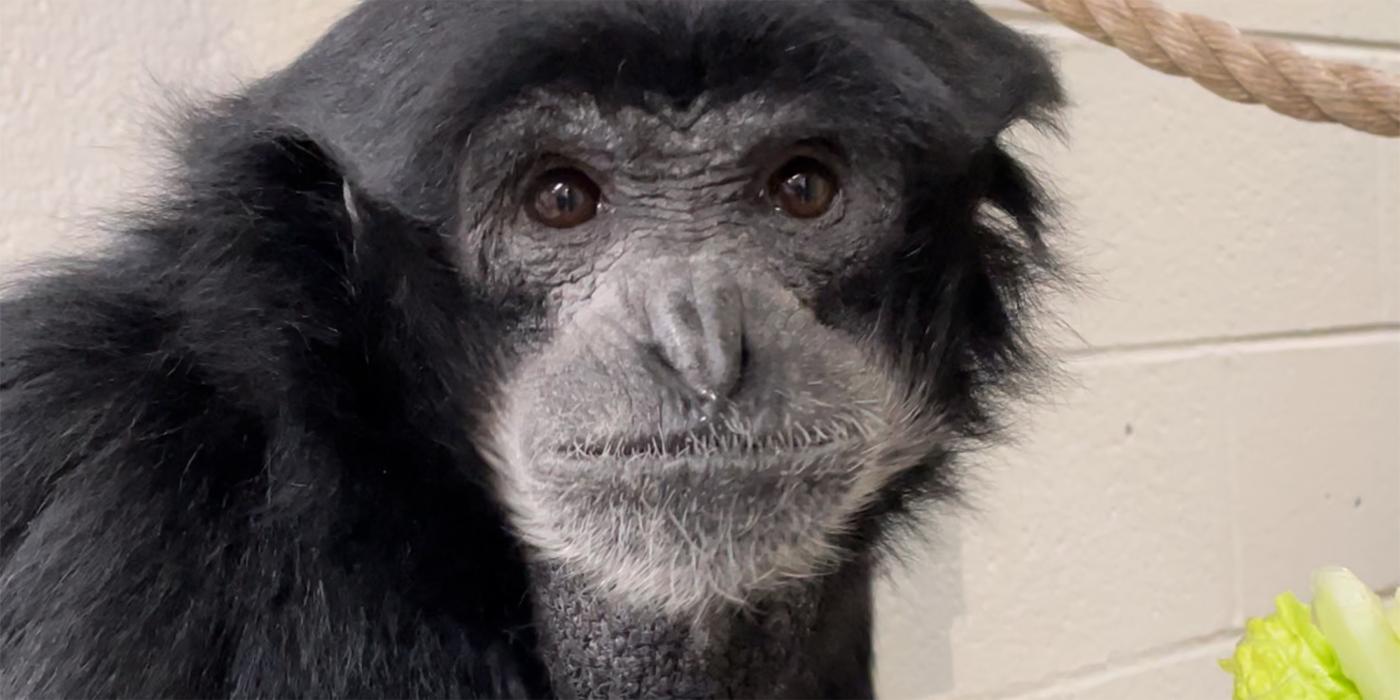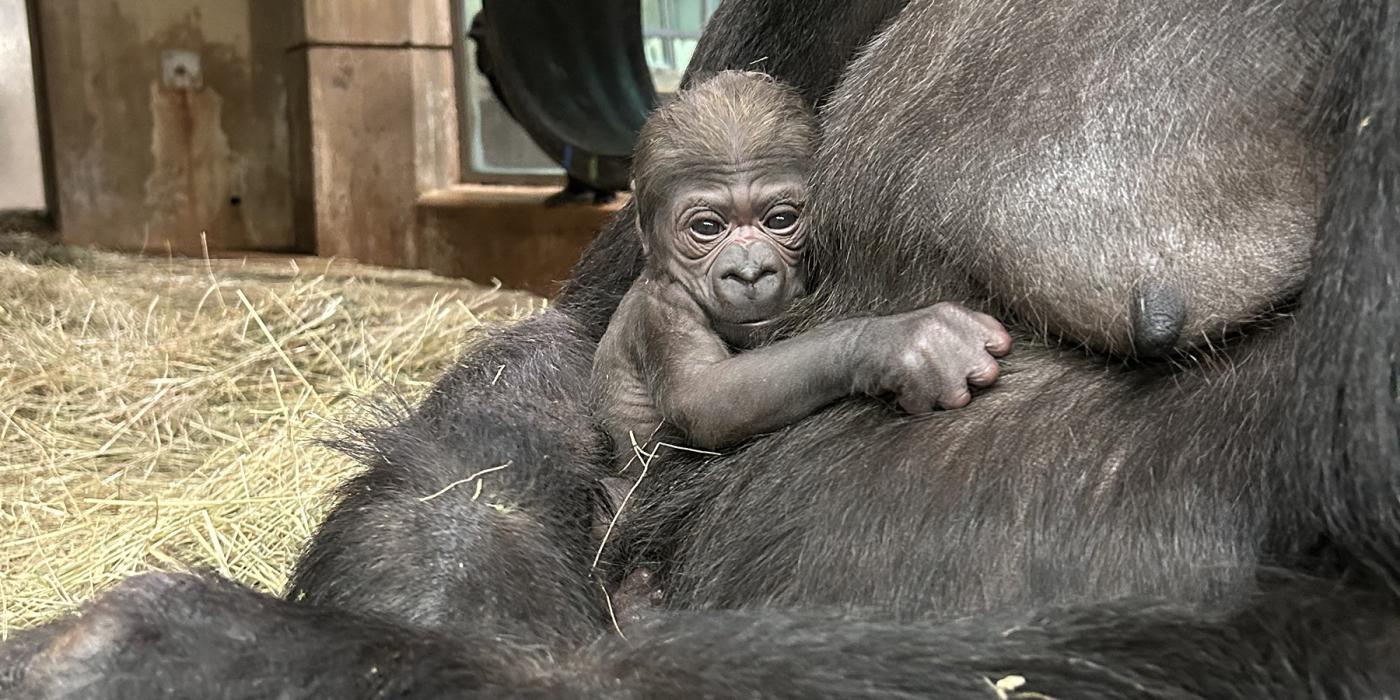A Day in the Life of Siamangs Adi and Guntur
Meet Adi and Guntur, our two new siamangs at Gibbon Ridge! They arrived at Smithsonian’s National Zoo and Conservation Biology Institute in fall 2021. Adi came to us from the El Paso Zoo in Texas, and Guntur hails from the Virginia Zoo. We introduced the pair in early 2022, and they are settling into their new routine. This includes sharing a building with their siamang neighbors, Ronnie and Bradley.
Adi and Guntur are quite a bit younger than Ronnie and Bradley—and they have a ton more energy! Over the past year, it has been really fun getting to know their personality quirks and watching their bond with each other grow. Let’s explore a day in the life of Adi and Guntur!
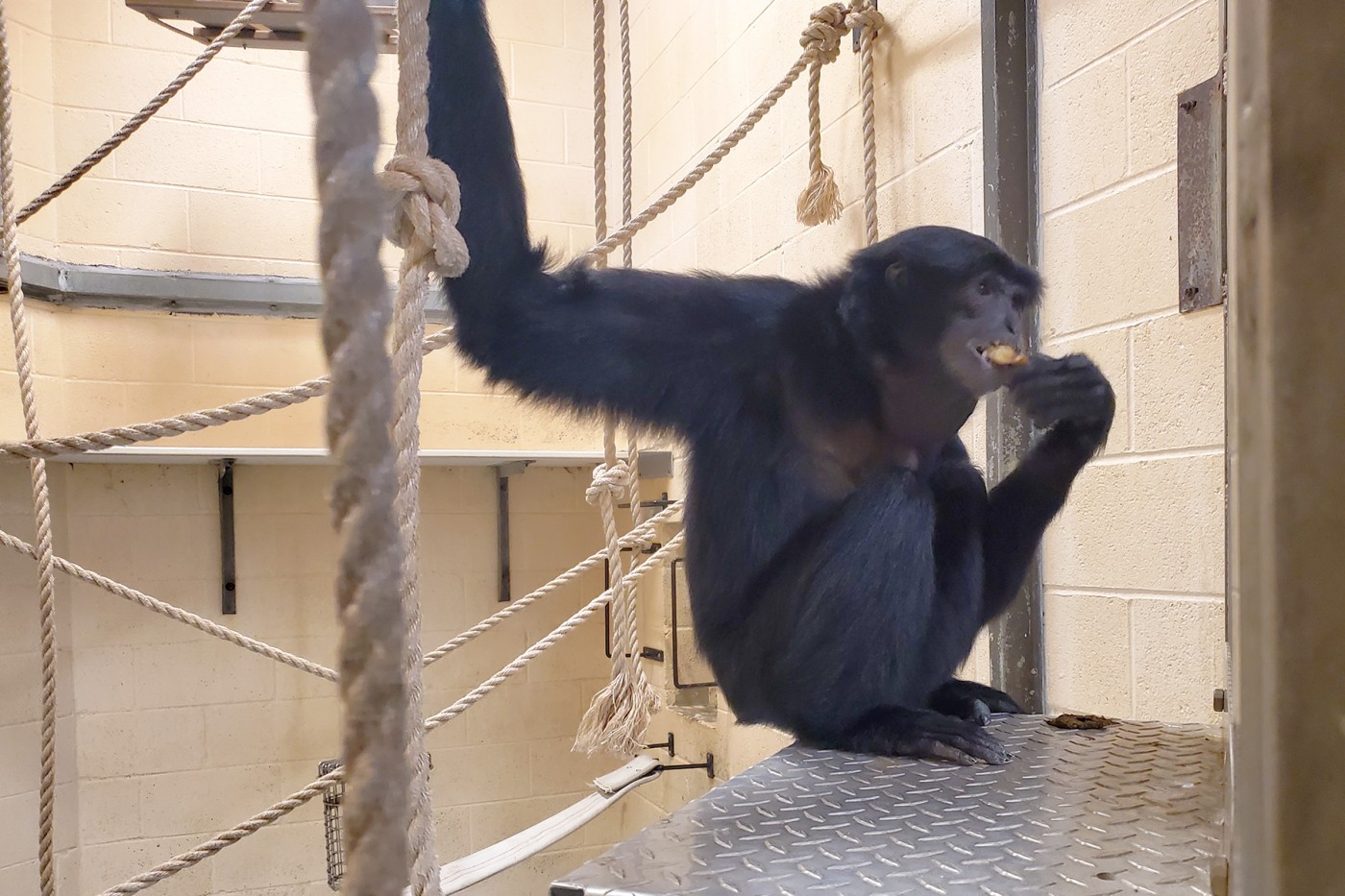
7.a.m. | Morning Check-In
The first thing I do when I arrive at Gibbon Ridge is a thorough check of our animals and their surroundings. This includes getting a good look at Adi and Guntur and making sure they appear healthy.
Adi is currently on oral birth control, which she eagerly takes in a raisin. I like to give each of them a chunk of banana to assess their appetite and get something in their tummies. This helps them have a little patience while I get their breakfast ready.
I also look at their stool from overnight and how much of their diet they have consumed or left behind. All of these things help me assess their health, so if any of these elements are ‘off’ we can address it right away.
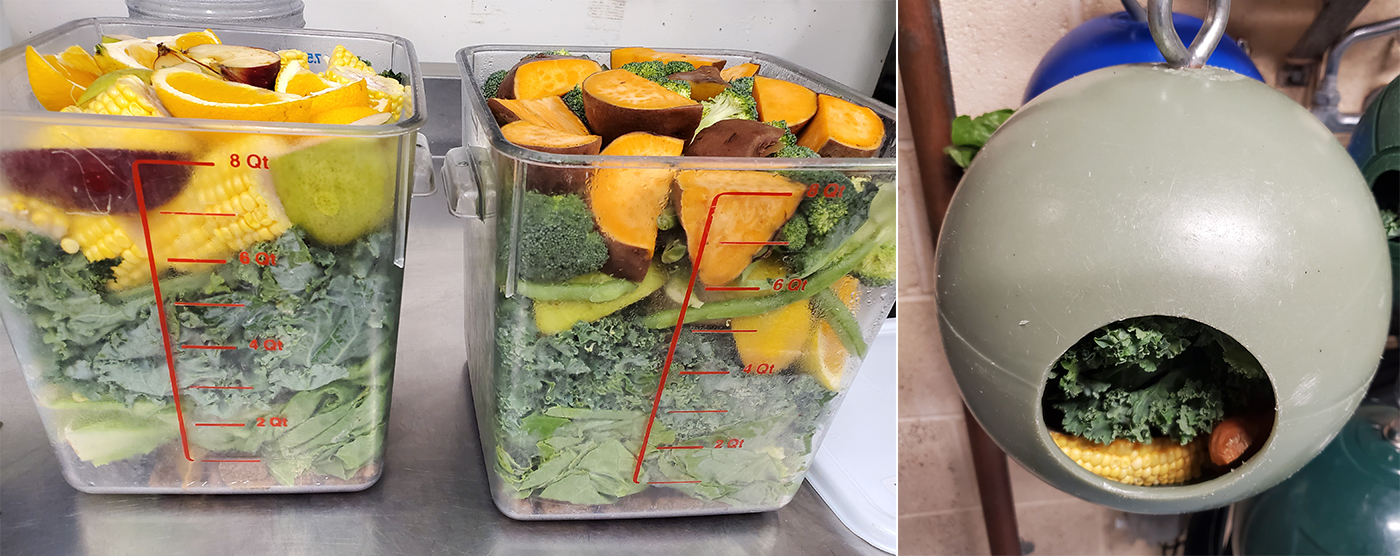
7:30 a.m. | Breakfast and Enrichment
It’s time to prepare Adi and Guntur’s diets! What do siamangs eat? Lots of greens, vegetables and a little fruit. They also receive a special chow diet that is made for primates. It comes in a biscuit form and has a ton of vitamins and nutrients packed into it. I place their diet into enrichment—objects they can see, touch, taste and smell. Adi and Guntur must work to get their food out of the objects, and this helps to keep them mentally and physically stimulated.
In this video: Siamang Adi forages for her breakfast. Keepers hang enrichment high and low, encouraging Adi to explore her habitat.
Every day, our siamangs receive at least four kinds of enrichment. Variety is important for primates, so we rotate through a bunch of different items and toys. They can choose to interact with the items for as long as they like. When paired with food, these toys can be especially enticing.
Some enrichment is as simple as a fruitsicle hidden inside a brown paper bag. Others are more complex. With puzzle feeders—such as boomer balls, PVC pipes and suet feeders—Adi and Guntur may need to shake, twist or otherwise manipulate the object to get the treats out. Once I place the diet into their toys, I hang them up in the outdoor habitat to encourage them to explore and forage.
In this video: A siamang’s call starts of slowly, then increases in speed. Often, they are accompanied by aerial acrobatics!
8 a.m. | Morning Duet
After breakfast, it’s time to duet! Early in the morning (and sometimes in the afternoon), Adi and Guntur sing with each other. Their vocalizations—a series of deep “booms,” loud “wows” and barks—can be heard throughout the Zoo! An inflatable sac on their throat allows them to create such loud calls.
In the wild, siamangs live in mated pairs, maintaining and defending their territory from other siamangs. When Adi and Guntur duet together, this strengthens their pair bonds and announces to other siamangs, like Ronnie and Bradley, to stay out of their territory.
In this video: Adi and Guntur tumble and play in their indoor enclosure.
10 a.m. | Playtime
After a busy morning of eating and singing, Adi and Guntur play and wrestle with each other. Tackling, slapping, biting and rolling are all good fun for these two! Often, Adi makes a cute squeaking noise when she wrestles with Guntur. In the wild, these behaviors would help young siamangs develop important social skills. Ronnie and Bradley, who are quite a bit older than their new neighbors, seem to prefer a more relaxed approach and can often be seen sunbathing on sunny days.
In this video: Keeper Lynne McMahan teaches Adi and Guntur behaviors that help the animal care team monitor their health.
11 a.m. | Training
Once Adi and Guntur have had their fun, it’s time to train! We teach all of our primates to cooperate in their own husbandry and health care. Using a combination of vocal cues and hand signals, we can ask our siamangs to move around their exhibit or present different body parts for inspection. If they do the behaviors asked of them, we give them lots of praise and a favorite food as a reward for a job well done.
Typically, Adi and Guntur’s training sessions take place in the late morning or early afternoon. Guntur is very excited about food, but sometimes he is not the best at sharing. If he is around, Adi can be shy and nervous about coming up to the mesh to train. It helps to have another keeper present so we can work with Adi and Guntur one-on-one.
In this video: Guntur and keeper Francesca Bozzo work on station training.
Francesca, my fellow primate keeper, has been helping me work on “station” training. I work with Adi, and she trains Guntur. Each siamang has a color-coded station that we hang on the mesh a few feet apart—Adi’s is yellow, and Guntur’s is red. When they sit by and touch their station, they receive a reward.
As they progress, we will move the stations closer together. Our goal is to be able to have one keeper train and feed the pair at the same time—without Guntur stealing Adi’s food, and without Adi getting nervous and moving away.
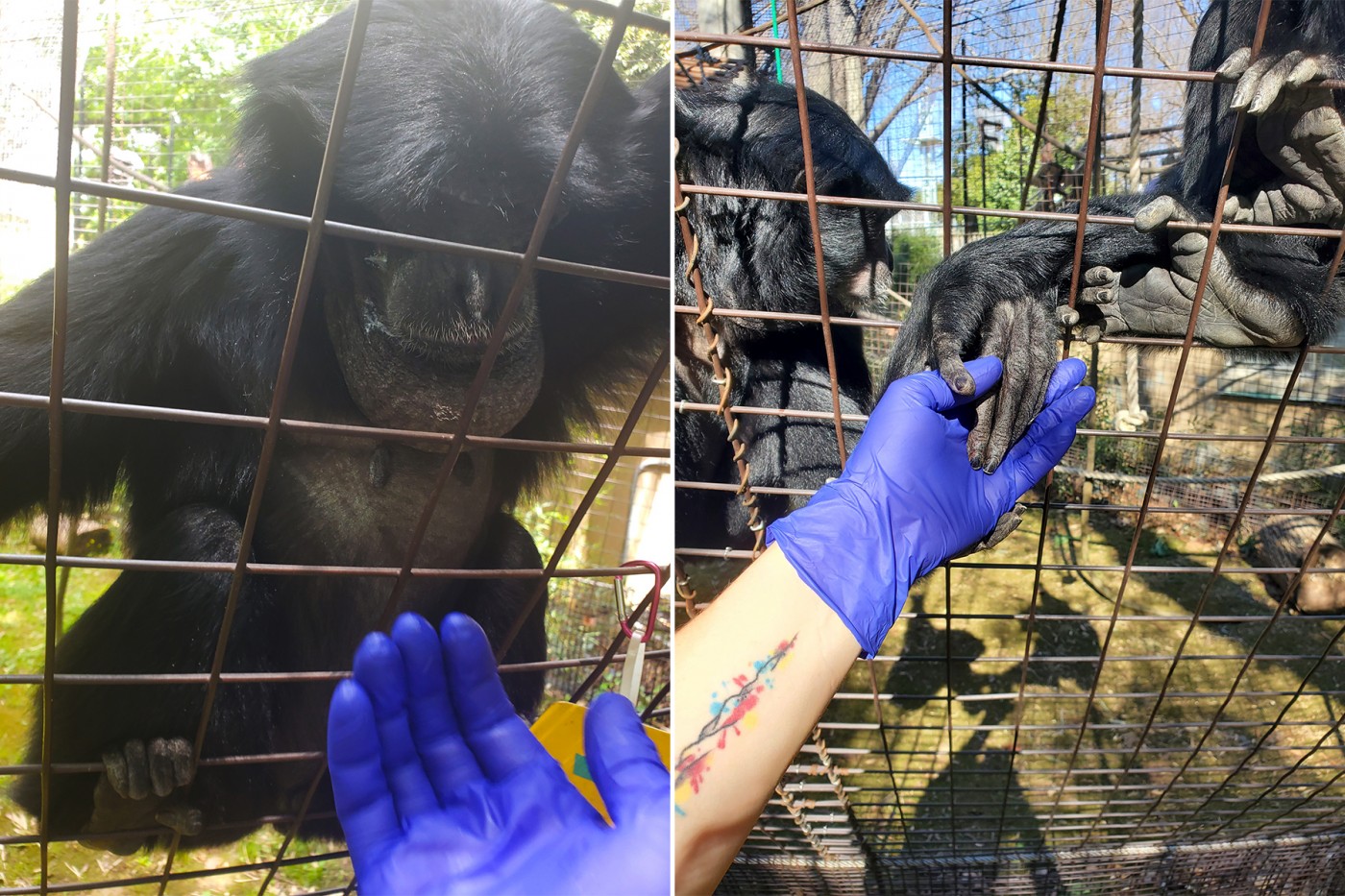
When Lynne gives the cue, Adi inflates her throat sac or presents her hand for evaluation.
Both Adi and Guntur are learning behaviors that will help us care for them. They include showing us their hands, feet, belly, head, tongue and hips. Adi can inflate her throat sac on cue, which is pretty cool! By teaching them to cooperate in their own medical care voluntarily, we can make the procedures much less stressful for them and us.
Medical behavior training usually takes place in the siamangs’ indoor enclosure. Both Adi and Guntur are learning to present their ears, enabling our animal care team to take their temperatures with a thermometer. We are working on blood draw training, too, which involves asking the siamangs to stick their arms into a PVC sleeve. Eventually, I will work with Adi on ultrasound training, which would help us monitor a pregnancy should she and Guntur receive a recommendation to breed from the Species Survival Plan.
Both Adi and Guntur successfully received their covid vaccinations voluntarily. This required them to present either their shoulder or hip up to the mesh of the enclosure and allow me to administer the injection. Afterwards, they both received a huge reward of bananas and apricots!
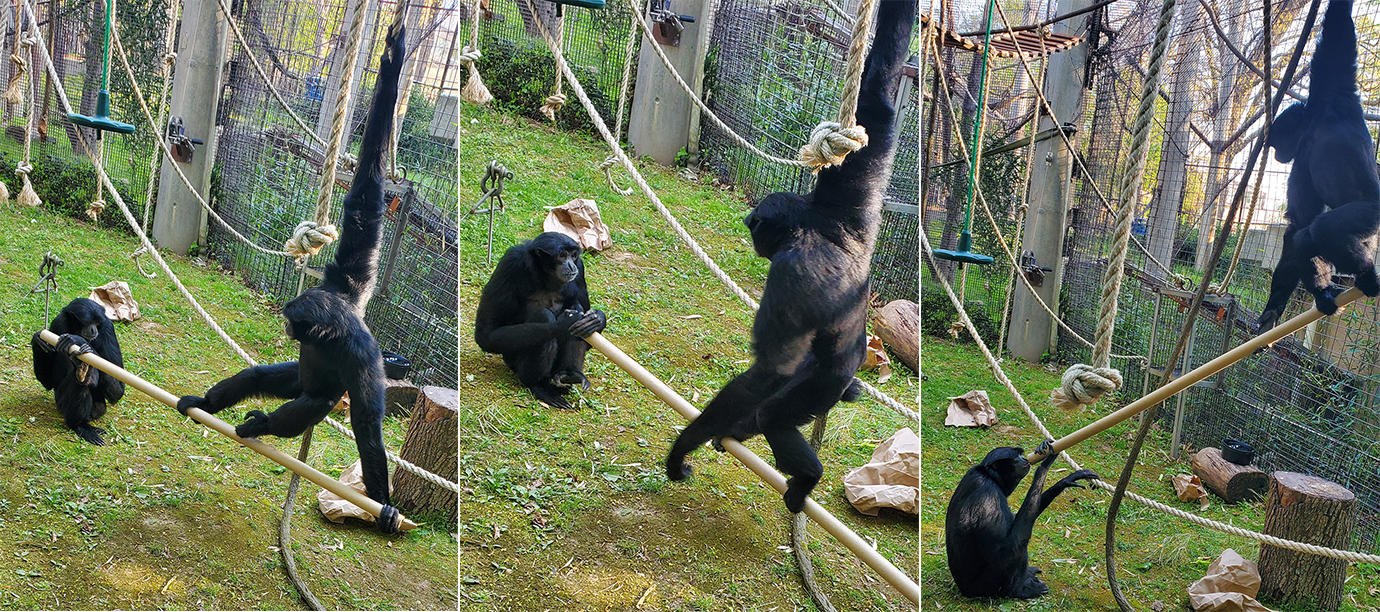
1 p.m. | Enrichment
After training, it’s time for another round of enrichment. Some of Adi and Guntur’s favorite items are cardboard tubes, socks stuffed with popcorn and kong wobblers with mealworms hidden inside. Both seem to enjoy shredding paper, and Guntur especially loves to thumb through, crinkle and rip up phone books!
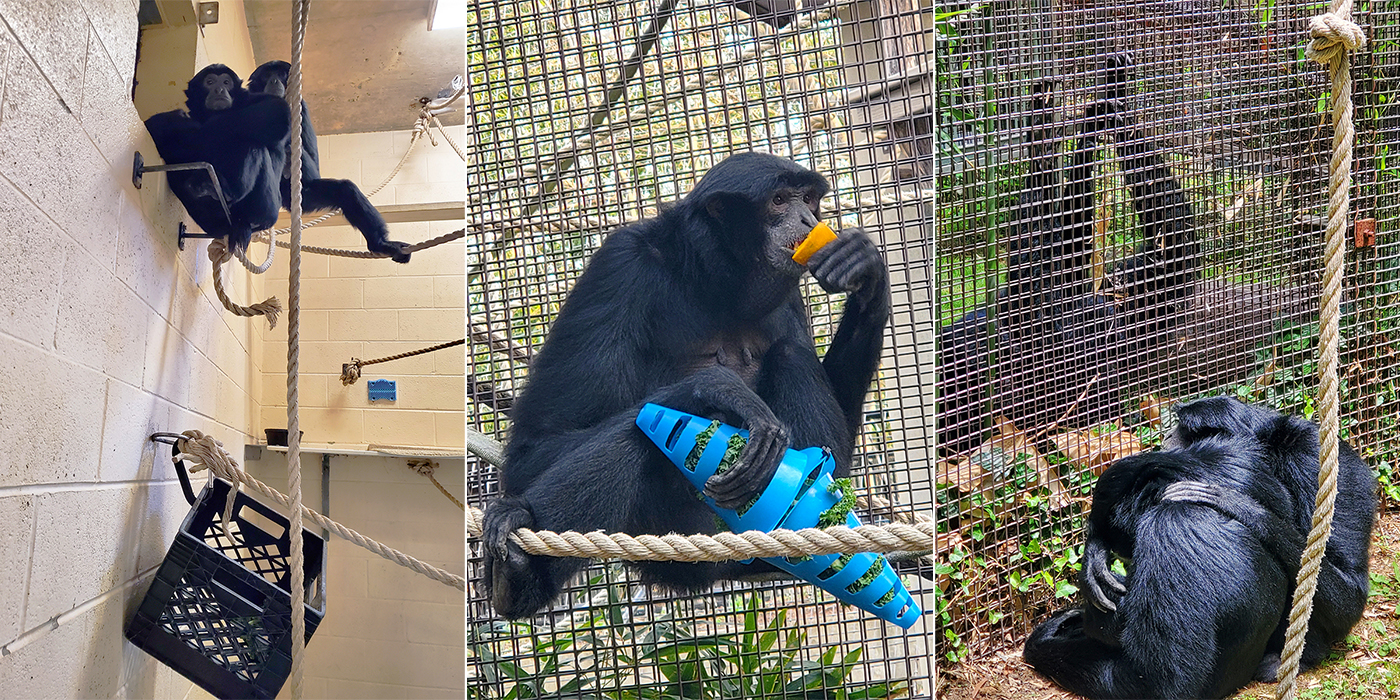
Adi and Guntur enjoy some snacks and spend quality time together at the end of another busy day.
2 p.m. | Dinnertime
Later in the afternoon, Adi and Guntur are given access to their indoor enclosures so they can choose whether they want to spend time outside or inside. Before we open the door, we set them up with their third enrichment for the day, plus the remainder of their diet. Their enclosure has shelves for resting, as well as ropes and firehose for moving and swinging around. There is also a hammock made of upcycled firehose that Adi and Guntur like to cuddle on together.
By the end of the day, they can be pretty tuckered out. Usually, they spend time resting and grooming each other. Wild siamangs do this, too! Grooming helps to strengthen pair bonds and keeps their skin and fur in good condition.
If the temperature outside is higher than 50 degrees Fahrenheit and the forecast is clear of thunderstorms, then Adi and Guntur can have access to both their indoor and outdoor exhibits overnight. This provides them some extra space, and they can enjoy some quiet time in the yard while the Zoo is closed.
Right before keepers leave for the day, we do one final check on Adi and Guntur to make sure they are all set for the night. This is when they get their fourth and final enrichment item, which gives them something to work on after we are gone.
With everyone fed and happy, it’s time to turn off the lights and lock up. Goodnight, Adi and Guntur, see you tomorrow!
Swing into the Smithsonian’s National Zoo and Conservation Biology Institute and visit siamangs Adi and Guntur at Gibbon Ridge! Want to learn more fun facts about gibbons? Check out How Long Are A Gibbon’s Arms? And More Gibbon Facts.
Related Species:
